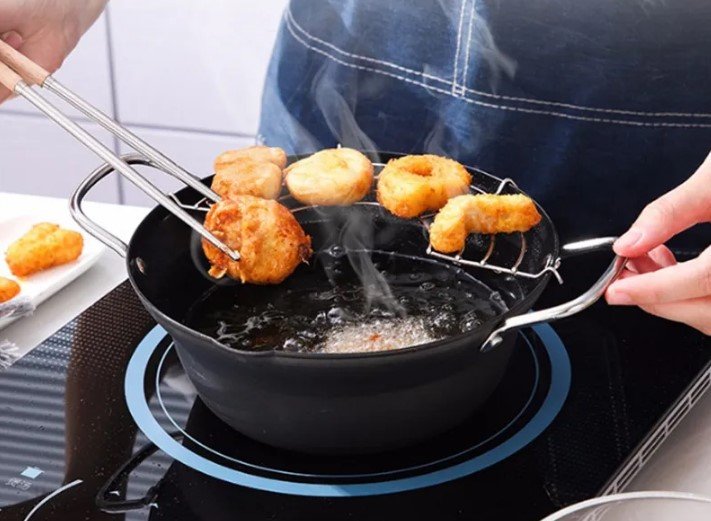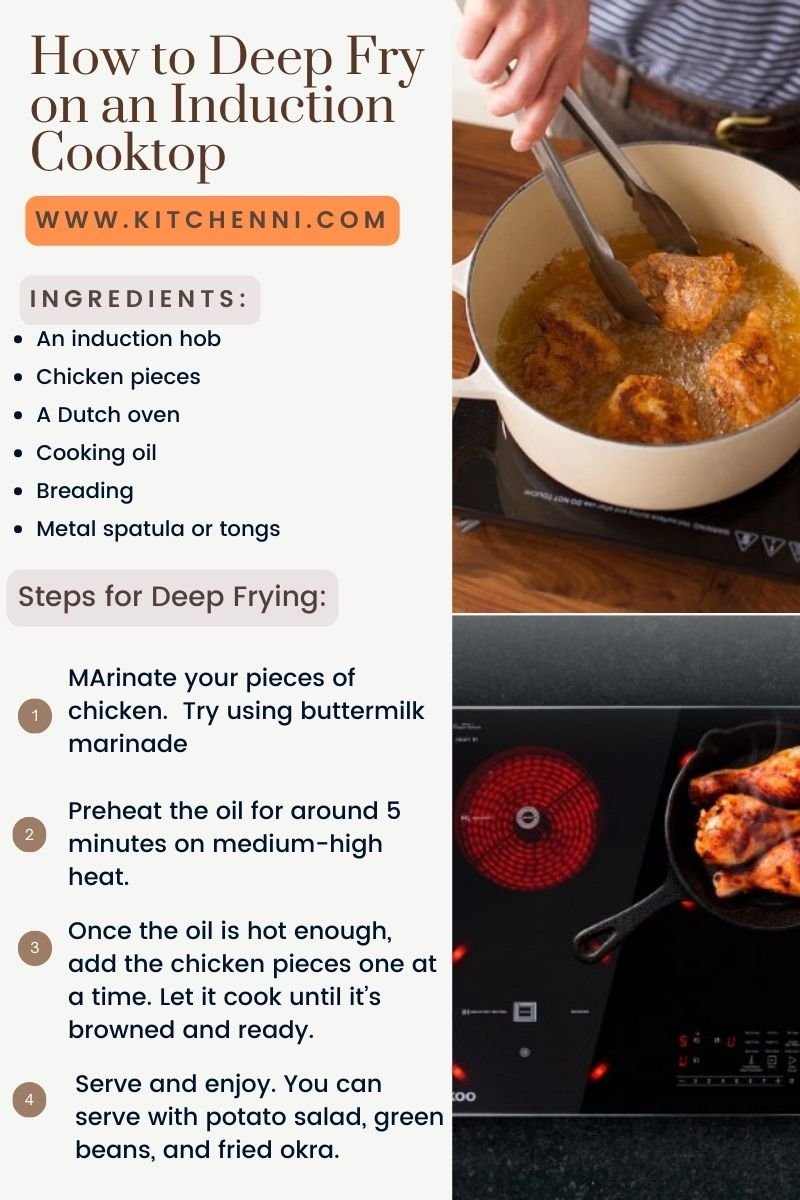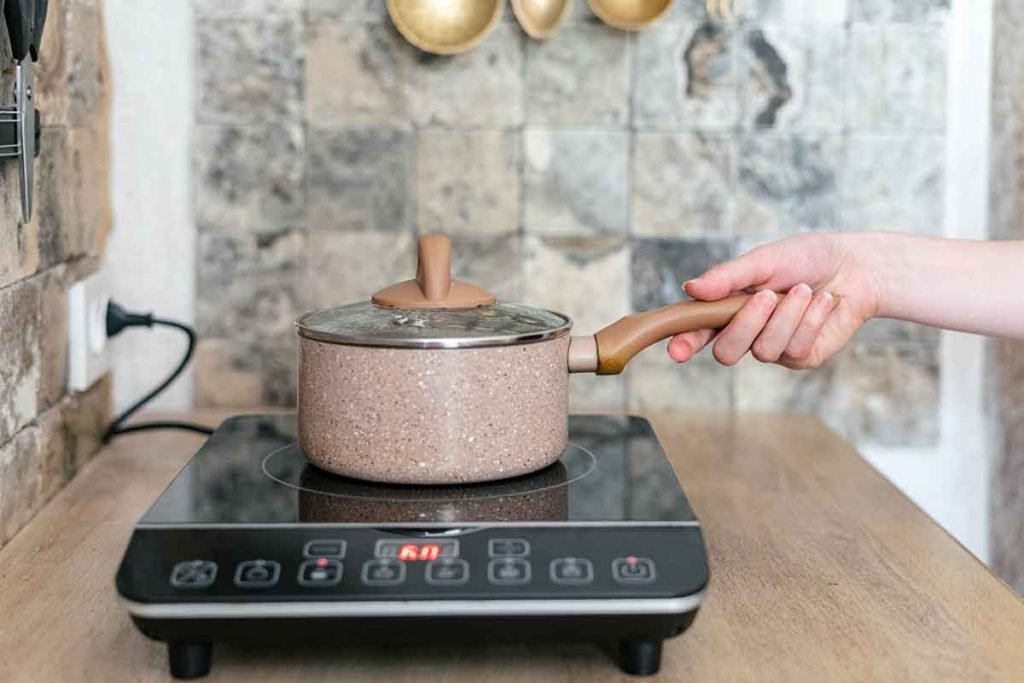Yes, you can deep fry delicious meals using an induction hob.
Statistics indicate that approximately 3% of people in the US have induction cookers. Are you one of these lucky individuals? They say once you switch to induction cooking, you never look back. I can attest to that.
I use my induction cooker for innumerable purposes, from boiling water and milk to stir-frying vegetables and deep-frying delicious chicken. Yes, I use my cooktop to deep fry chicken, and I’m loving it. If you haven’t tried it yet, you’re missing out.
One of the perks of deep frying with an induction cooktop that I’ve discovered is this appliance supports precise temperature control. And that, my friend, is why my deep-fried chicken is fabled in my homestead and neighborhood.
How to Deep Fry on an Induction Cooktop
How to Deep Fry on an Induction Cooktop Infographic
I use my induction cooktop to deep fry various foods, ranging from tempura vegetables and fish fillets to French fries and churros. But my utmost favorite is crispy, deep-fried chicken.
Now, am I the only one who’s obsessed with deep-fried chicken? I don’t think so. After all, in 2020 alone, nearly 179 million Americans purchased and consumed frozen fried chicken. Let me show you how I deep fry perfect chicken using my cooktop. Note down every little detail.
What you need:
- An induction hob
- Chicken pieces
- A Dutch oven
- Cooking oil
- Breading
- Metal spatula or tongs
Step 1: Prepare Your Chicken
Pick a few raw chicken pieces for deep frying. But don’t wash them. Most people wash their poultry before cooking, which is a terrible idea. If you wash the raw chicken pieces, you’ll transfer bacteria and germs to other utensils or food in your kitchen. Let heat kill any critters present.
If you want juicy chicken, submerge the raw pieces in brine and let them soak in the solution for approximately 10 hours. That’s what I always do. Then, marinade the pieces. Try using buttermilk marinade, which I consider the key to making succulent chicken. Finally, if you like enjoying chicken with a crispy crust, dredge the pieces in breading. Lay out the breaded pieces for approximately 20 minutes.
Step 2: Heat Enough Cooking Oil
Pour some oil into the Dutch oven. It should be enough to cover all the chicken pieces. You should always use oils that have a high smoking point. I often use palm oil, whose smoke point is above 450°F. Other excellent options besides palm oil include canola, peanut, and coconut oils.
Preheat the oil for around 5 minutes on medium-high heat.
Step 3: Fry Your Chicken
Once the oil is hot enough, add the chicken pieces one at a time. Use a metal spatula or tongs. Consider deep frying no more than four pieces at a time to avoid overcrowding. While adding the chicken pieces into the hot oil, be extra cautious. Do not drop them anyhow since the oil might splatter and burn you. Remember, 7% of all burn patients have hot cooking oil to blame.
Let the chicken cook until it’s browned and ready. That should take approximately 10 minutes.
Step 4: Serve and Enjoy
You can eat deep-fried chicken with almost anything. I often enjoy this delicacy with different side dishes, including potato salad, green beans, and fried okra. Store any leftovers in your refrigerator. It will last for up to 4 days. But, if you don’t have a fridge, you might have to throw away any pieces that sit out in the open for more than 2 hours. That’s what the USDA recommends.
What’s the Ideal Temperature to Deep Fry on an Induction Stove
The ideal temperature for deep frying most foods on an induction cooker is 450°F. But anything above 350°F can do the job nicely. I recommend you go with the former if you can. Since it’s significantly higher, it’ll enable you to prepare chicken with an enticing golden color and crisp texture. Moreover, it’ll allow you to cook much faster.
How Much Oil Should You Use for Deep-Frying
As I mentioned earlier, oil should be enough to cover everything you want to prepare fully. Just pour oil into the cookware until you determine it’s enough to submerge whatever you’re deep frying, be it chicken, beef, fish fillets, etc.
Why not Fry a Turkey on a Portable Induction Stove?
Portable induction cooktops are compact-sized and can’t accommodate large cookware. As you may know already, frying turkey calls for bigger pots. You likely wonder, can’t you use a big pot on a small cooktop? Sure, you can. But you shouldn’t.
I highly advise against using a large pot to fry turkey on a small portable cooktop for one primary reason. The difference in size between the stove’s heating element and the cookware’s bottom surface will undermine energy efficiency. Plus, it may lead to uneven heating.
Best Induction Pan for Deep Frying
The best induction pan for deep frying is made of stainless steel. However, you can also use cast iron or enameled iron cookware. The bottom line here is any pan made of a magnetic material is suitable for deep frying on an induction cooktop. If you don’t have cookware made from such materials, use an aluminum or copper pan with a magnetized base.
How to Protect Your Induction Stove While Deep Frying
Induction hobs are fragile appliances that can be damaged easily. So, when deep frying with it:
Don’t bang a pot or pan against the glass top. If you do that too often, the top surface might crack or shatter. And you can’t repair a cracked induction glass top; you can only replace it, which costs hundreds of dollars.
Cover the induction hob’s cooking surface with an oven-grade silicone mat. It will stop your pan from moving around and scratching the pristine glass top. And don’t worry; these items are designed to withstand significant heat.
Wipe oil spills from the cooktop a few minutes after using the appliance. Don’t let it sit on the glass top too long because burnt-on oil is hard to remove. But, to avoid getting burned, don’t wipe the surface immediately after cooking with your induction hob. Give it a few minutes to cool down.
Final Thoughts
Deep frying delicious foods using your induction stove is possible. I highly recommend trying it, especially if your cooktop has precise temperature control.
Additionally, I often encourage people to use induction hobs to deep fry since these appliances save energy. If you doubt me, consider this one example. According to the US Department of Energy, induction stoves are approximately 3x more efficient than their gas counterparts. Are you sold now?
Here’s to deep-frying lip-smacking delicacies with induction cooktops!
Common Questions
Is it possible to deep fry foods on an induction cooktop?
Yes, induction cooktops can absolutely be used for deep frying at home. The high power and precise temperature control induction provides is ideal for maintaining oil temperature for even frying.
What type of cookware works best for induction deep frying?
Use a large enameled cast iron or stainless steel Dutch oven or deep skillet with high sides. Look for induction-compatible cookware designed for deep frying.
Can induction cooktops heat oil to high temperatures fast?
Yes, induction excels at swiftly heating oil to the ideal frying temperature thanks to its power and immediate heat response. It brings oil to temp much quicker than gas or electric ranges.
Is temperature regulation consistent during induction deep frying?
Induction provides very steady heat, so the oil temp remains consistent, preventing hot or cool spots. The oil won’t cool significantly when adding food either.
What precautions should be taken for safe deep frying?
Do not overfill oil. Allow space for bubbling when cooking. Monitor temp closely. Turn off immediately if oil starts smoking. Never leave it unattended.
How easy is clean up after induction deep frying?
The smooth glass surface wipes down easily. Use caution when handling hot oil. Let oil cool before discarding. Scrub pan thoroughly after use.




